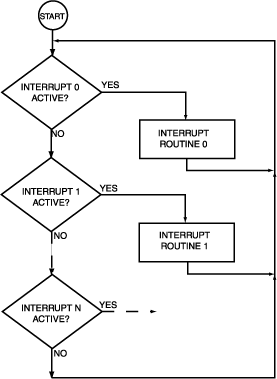Bit-Slice Design: Controllers and ALUs
by Donnamaie E. White
Copyright © 1996, 2001, 2002 Donnamaie E. White
- Pre-Introduction
- Selection of the Implementation
- Microprogramming
- Advantages of LSI
- The 2900 Family
- Language Interrelationships
- Controller Design
- Constructing the CCU
- Sequential Execution
- Multiple Sequences
- Start Addresses
- Mapping PROM
- Unconditional Branch
- Conditional Branch
- Timing Considerations
- Pipelining
- Improved Architecture
3. Adding Programming
Support to the Controller
- Expanded Testing
- Subroutines
- Nested Subroutines
- Stack Size
- Loops
- Am29811
- Am2909/11
- CASE Statement (Am29803A)
- Microprogram Memory
- Status Polling
- Interrupt Servicing
- Implementation - Interrupt Request Signals
- Vector Mapping PROM
- Next Address Control
- Am2910
- Am2910 Instructions
- Control Lines
- Interrupt Handling
- Am2914
- Interconnection of the Am2914
6. The ALU and Basic Arithmetic
- Further Enhancements
- Instruction Fields
- Instruction Set Extensions
- Sample Operations
- Arithmetic -- General
- Multiplication with the Am2901
- Am2903 Multiply
Refining the CCULast Edit November 2, 1996; May 1, 1999; July 7, 2001 In a microcomputer system there is a need to interface the main or central unit (microprocessor and/or control unit) to one or more external devices such as sensors, displays, control panels, keyboards or external memory. The main objective is to design the interface to minimize the effect of the interface activities on the system throughput or performance. Any contact with any external device will be considered as input/output handling or I/O. Although there are many schemes for handling I/O requests, interrupts and queuing will be covered very lightly herein, principally as a means of alerting the designer to the existence of the problems. (The subject warrants its own seminar.) Only those schemes relevant to firmware design will be explored in any detail. There are two very basic methods of I/O handling - status polling and interrupt servicing. Status PollingWith status polling, the controlling unit must interrogate each peripheral to determine if it needs servicing by testing the status line of each peripheral, one at a time. This might be by the elementary "Round Robin" approach, where the devices are tested in a set, circular sequence. Where different devices are to be handled on a priority basis, priority is accomplished by assigning high-priority devices to more than one location in the testing sequence. A high-priority device is tested with a higher polling frequency than the low-priority items. Figure 4-1 Status polling microprogram flowchart
Problems
When to Use or Not UseThe scheme is suitable if the frequency of service requests for each device is known with some degree of accuracy. This allows the polling frequency to be custom-tailored to the system. The service time, once a request for service is acknowledged, should be long compared to the estimated wait time. It is not an advisable scheme where interfacing to a human is involved; that is, requests should be primarily I/O to hardware devices. (Human patience tends to decrease with exposure to computers; and has dropped from minutes (way back) to 30 sec (60's) to 1-3 sec. Look at the operating speeds of 1980's PCs (200-250MHz) compared to 16MHz systems, and the forecasted 500MHz systems (1998-9). Even children's game systems are at 64-bit computing speeds and climbing and these children will demand even faster response. Or, watch someone trying to access the Internet during internet traffic jams. Humans want instant gratification. The normal phone connection came and went in and out of vogue in less than three years because it is not fast enough to keep up with the increasingly more demanding computer user. |
